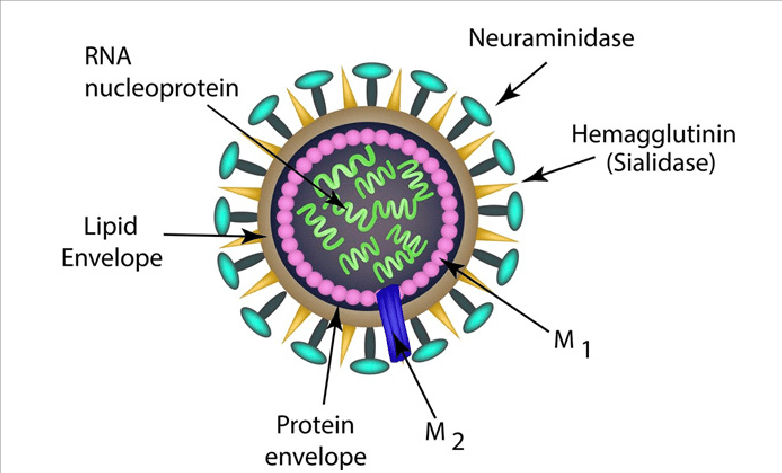
3D cell culture models for Influenza viruses
Traditionally cell based studies for respiratory viruses were performed on 2D monolayer cell cultures. In-vivo studies heavily relied on animal models. Both types of models however were not successful at accurately mimicking the in-vivo physiology and pathophysiology of cells in responses to viral infection. Consequently 3D cell culture models have been developed in an attempt to accurately represent human in-vivo state of tissues, extracellular environment and mimc viral tissue response, kinetics and host-viral interactions (1).
Influenza Viruses
Influenza is a continuously evolving virus that is capable of infecting a wide range of avian and swine hosts, as well cross species infections, and ultimately infecting humans. Previous outbreaks of avian and swine influenza and the high mortality rates and are prime examples of its severe impact on global health. Despite the challenges encountered in producing an appropriate in vitro model of study, 3D cell culture methods has provided several promising platforms for influenza research (2,3).
3D culture systems for influenza virus
3D aggregates of airway respiratory cells have proved to be a reliable model compared with the traditional 2D monolayer cultures, and other models such as bronchus explant cultures. Airway organoids are deemed as a viable platform for influenza studies. Airway organoids are developed from human lung stem cells, that are subsequently differentiated in to goblet cells, and epithelial cells equipped with active cilliary structures. Both these models exhibited similar viral titres, viral kinetics and were representative of viral infection in vivo, with increased inflammatory response observed with increased pathogenicity of the strain (4). Other models include adult stem cells (ASC) organoids differentiated into ciliated, goblet, basal and club cells, that when infected with the virus indicated enhanced the propagation of the human-infective strains in a time period similar to that found in vivo (5).
3D models of mouse epithelial progenitor cells are also used to investigate lung injury and restricted tissue repair caused by the virus as well as potential therapeutics that can be used to reverse the adverse effects observed (6). Furthermore 3D cultures of primary human small airway epithelial cells (HSAEpCs) cultivated on an air–liquid interface (ALI) matrix were proven to be a physiologically relevant model than the traditional 2D monolayers (7). These models therefore further confirms the use of 3D models as a reliable platform for studying the pathogenicity of influenza viruses, identify potential targets for therapeutics and predict the potential of influenza strains to cross between species that can cause an eventual outbreak, affecting the global population.
References
1. Harb, A.; Fakhreddine, M.; Zaraket, H.; Saleh, F.A. Three-Dimensional Cell Culture Models to Study Respiratory Virus Infections Including COVID-19. Biomimetics 2022,7,3.
2. Peiris, J.S.M.; de Jong, M.D.; Guan, Y. Avian Influenza Virus (H5N1): A Threat to Human Health. Clin. Microbiol. Rev. 2007, 20, 243–267.
3. Neumann, G.; Noda, T.; Kawaoka, Y. Emergence and pandemic potential of swine-origin H1N1 influenza virus. Nat. Cell Biol. 2009, 459, 931–939.
4. Hui, K.P.Y.; Ching, R.H.H.; Chan, S.K.H.; Nicholls, J.M.; Sachs, N.; Clevers, H.; Peiris, J.S.M.; Chan, M.C.W. Tropism, replication competence, and innate immune responses of influenza virus: An analysis of human airway organoids and ex-vivo bronchus cultures. Lancet Respir. Med. 2018, 6, 846–854.
5. Zhou, J.; Li, C.; Sachs, N.; Chiu, M.C.; Wong, B.H.-Y.; Chu, H.; Poon, V.K.-M.; Wang, D.; Zhao, X.; Wen, L.; et al. Differentiated human airway organoids to assess infectivity of emerging influenza virus. Proc. Natl. Acad. Sci. USA 2018, 115, 6822–6827.
6. Quantius, J.; Schmoldt, C.; Vazquez-Armendariz, A.I.; Becker, C.; El Agha, E.; Wilhelm, J.; Morty, R.E.; Vadász, I.; Mayer, K.; Gattenloehner, S.; et al. Influenza Virus Infects Epithelial Stem/Progenitor Cells of the Distal Lung: Impact on Fgfr2b-Driven Epithelial Repair. PLoS Pathog. 2016, 12, e1005544.
7. Bhowmick, R.; Derakhshan, T.; Liang, Y.; Ritchey, J.; Liu, L.; Gappa-Fahlenkamp, H. A Three-Dimensional Human Tissue- Engineered Lung Model to Study Influenza A Infection. Tissue Eng. Part A 2018, 24, 1468–1480.
8. Ibekwe, Titus & Kwaghe, Vivian & Habib, Zaiyad & Ibekwe, Perpetua. (2021). The Role of Antiviral Drugs in the Case-Management of Respiratory Syncytial Virus, Influenza and COVID-19.



